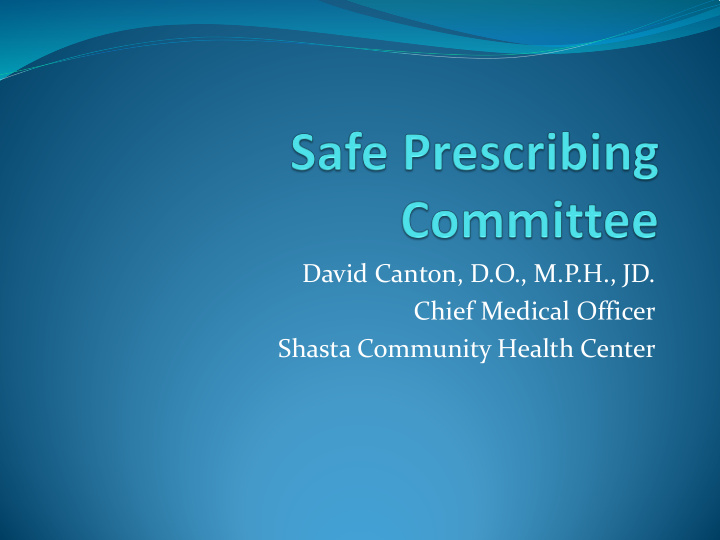



David Canton, D.O., M.P.H., JD. Chief Medical Officer Shasta Community Health Center
The Start Pain Committee Started in 2012 Developed Primary Care management guidelines Management agreement Informed consent Provide comfort for Cross coverage
The Committee Meetings Make up 6 clinicians including one behavioral health Nurses Administrative staff Authority of the CMO
Next Step Began to look at all Controlled substances Benzo’s and their cousins Marijuana Changed name to Safe Prescribing Committee Set goals for Management Agreement and tracked Set goals for Urine Tox and tracked Notified patients effected
Timeline February 2014, we sent out 374 letters to patients on high dose opiates telling them of our new policy. April 2014 -- Our first pain brochure was completed April 2014 -- We revised the Pain Management Guidelines May 2014 – We looked at the average number of visits of patients with and without chronic pain meds, and tested for significance at the clinician and the Center level. Jan 2015 – SCHC pain brochure modified to include No ethol and marijuana and opiate medications.
Current functions Consultant resources Send request to chair Tapering recommendations Dosing recommendations Engagement recommendations Monitor compliance Monthly monitoring Medical Director management Evaluation factor
Where Are We? August 2013: 2969 patients on chronic pain meds, 136 patients on high dose opiates January 2014: 3053 patients on chronic pain meds, 358 patients on high dose opiates (the expansion brought in some new patients) December 2014 –2875 on chronic pain meds. 386 patients on high dose opiates May 2015 – 2652 on chronic pain. About 100 patients on high dose opiates.
A graphic look at moving from QA to QI Good QI- hitting the threshold consistently, little variation Good QA – Consistent hitting the poor threshold quality Mediocre (on average) quality, on average hits the threshold, but a lot of variation 8
Numerous report formats “tested” Percent Chronic Pain Med Patients with Agreements, Utoxes and PARS Chronic Pain Meds - % with By Percent in Team Adult Patient Panel Med Management 100 Agreement 90 100% 80 80% 60% 70 40% 60 Percent 20% 50 0% 8/31/2013 9/21/2013 10/21/2013 11/18/2013 12/16/2013 1/23/2014 2/22/2014 3/22/2014 4/29/2014 5/23/2014 6/23/2014 7/19/2014 40 30 20 10 As of June 23, 2014 (Established and No PCC) As of July 19, 2014 (Established and No PCC) Trend- June-July 2014 ** FP-Blue FP-Gold 0 PAIN-Has % PAIN- PAIN-Has % PAIN- Change in Change in FP-Green HOPE Total a Med has a Med % PAIN- Total a Med has a Med % PAIN- Number % Med 0 5 10 15 20 25 30 35 40 HV AND Percent Chronic Pain Med Patients in Team Panel PAIN Mgmt PAIN-Had Mgmt had a PAIN Mgmt PAIN-Had Mgmt had a of Mgmt Change in RES SL Team Meds contract a utox contract Utox Meds contract a utox contract Utox Patients contract % Utox July 2014 Established 77 32 30 41.6% 39.0% 93 21 26 22.6% 28.0% ↓ ↓ With Med Agreement With Utox With PARS SPC UC FP-Blue 87 48 44 55.2% 50.6% 107 44 49 41.1% 45.8% ↓ ↓ Agreement-Utox Pair Agreement-PARS Pair FP-Gold 531 288 320 54.2% 60.3% 684 231 371 33.8% 54.2% ↓ ↓ FP-Green 430 333 295 77.4% 68.6% 533 310 363 58.2% 68.1% ↓ − Mar 21 2015. HOPE 20 9 12 45.0% 60.0% 5 0 1 0.0% 20.0% ↓ ↓ HV 230 205 174 89.1% 75.7% 314 226 237 72.0% 75.5% ↓ ↓ No PCC 84 26 18 31.0% 21.4% 162 23 24 14.2% 14.8% ↓ ↓ PEDS 11 3 3 27.3% 27.3% 14 2 2 14.3% 14.3% ↓ ↓ Purple 265 192 177 72.5% 66.8% 327 193 209 59.0% 63.9% ↓ ↓ RES 494 356 339 72.1% 68.6% 601 319 393 53.1% 65.4% ↓ ↓ SL 379 288 274 76.0% 72.3% 429 261 302 60.8% 70.4% ↓ ↓ SPC 567 376 321 66.3% 56.6% 714 412 409 57.7% 57.3% ↓ − UC 223 110 67 49.3% 30.0% 269 92 79 34.2% 29.4% ↓ − Grand Total 3398 2266 2074 66.7% 61.0% 4252 2134 2465 50.2% 58.0% ↓ ↓ 9
Are we making progress? Proportion of patients on opioid medications has remained fairly stable Percent Adult Patients on Chronic Pain Medication in PCC Panels Over Time 40 Upper value 30 75 th % Adult Pain pats' percentile 20 Median (50%) 25 th 10 percentile Lowest value 0 2015-01-24 2015-02-22 2015-03-21 10
Proportion of patients with current med management agreements is increasing Percent Adult Patients on Chronic Pain Medication with Current Med Management Agreements in PCC Panels Over Time 100 Less 80 variation is % With Med Agreement good. Means that teams are more 60 consistently getting/upda ting med 40 management agreements. 20 2015-01-24 2015-02-22 2015-03-21 11
Proportion of patients with current utoxes is increasing Percent Adult Patients on Chronic Pain Medication with Current Utox in PCC Panels Over Time 100 Less 90 variation is good. % With Utox 80 Means that teams are more 70 consistently doing utoxes. 60 50 2015-01-24 2015-02-22 2015-03-21 12
Proportion of patients with current PARS/CURES is increasing Percent Adult Patients on Chronic Pain Medication with Current PARS in PCC Panels Over Time 100 80 % With PARS 60 More variation 40 is good. Means that teams 20 are getting PARS reports. 0 2015-01-24 2015-02-22 2015-03-21 13
Lessons Learned Needed a clear (and repeated) articulation of policies and guidelines Provided patient information about the policy Try out different data presentations – not all will work, not all will work forever Enjoy the success 14
Questions Comments David Canton, DO, M.P.H., J.D. dcanton@shastahealth.org
Recommend
More recommend